It's just about go time. Most likely place for the eyewall to make landfall is between Tampa Bay and Sarasota.
000
WTNT34 KNHC 092055
TCPAT4
BULLETIN
Hurricane Milton Advisory Number 19
NWS National Hurricane Center Miami FL AL142024
500 PM EDT Wed Oct 09 2024
...MILTON APPROACHING THE COAST OF WEST-CENTRAL FLORIDA...
...LIFE-THREATENING STORM SURGE, DAMAGING WINDS, AND FLOODING RAINS
EXPECTED ACROSS PORTIONS OF CENTRAL AND SOUTHWESTERN FLORIDA...
SUMMARY OF 500 PM EDT...2100 UTC...INFORMATION
----------------------------------------------
LOCATION...26.9N 83.4W
ABOUT 60 MI...100 KM WSW OF SARASOTA FLORIDA
ABOUT 170 MI...275 KM SW OF ORLANDO FLORIDA
MAXIMUM SUSTAINED WINDS...120 MPH...195 KM/H
PRESENT MOVEMENT...NE OR 35 DEGREES AT 17 MPH...28 KM/H
MINIMUM CENTRAL PRESSURE...948 MB...28.00 INCHES
WATCHES AND WARNINGS
--------------------
CHANGES WITH THIS ADVISORY:
The Tropical Storm Watch north of the Savannah River to Edisto
Beach South Carolina has been upgraded to a Tropical Storm Warning.
The Hurricane Watches for the Dry Tortugas, the Florida east coast
north of Ponte Vedra Beach to the mouth of the St. Marys River, and
for the Florida west coast from Chokoloskee to south of Bonita
Beach have been discontinued.
The Tropical Storm Watch north of Edisto Beach has been
discontinued.
SUMMARY OF WATCHES AND WARNINGS IN EFFECT:
A Storm Surge Warning is in effect for...
* Florida west coast from Flamingo northward to Yankeetown,
including Charlotte Harbor and Tampa Bay
* Sebastian Inlet Florida to Altamaha Sound Georgia, including the
St. Johns River
A Hurricane Warning is in effect for...
* Florida west coast from Bonita Beach northward to Suwannee River,
including Tampa Bay
* Florida east coast from the St. Lucie/Martin County Line northward
to Ponte Vedra Beach
A Hurricane Watch is in effect for...
* Lake Okeechobee
* Florida east coast from the St. Lucie/Martin County Line to the
Palm Beach/Martin County Line
A Tropical Storm Warning is in effect for...
* Florida Keys, including Dry Tortugas and Florida Bay
* Lake Okeechobee
* Florida west coast from Flamingo to south of Bonita Beach
* Florida west coast from north of Suwanee River to Indian Pass
* Florida east coast south of the St. Lucie/Martin County Line to
Flamingo
* North of Ponte Vedra Beach Florida to Edisto Beach South Carolina
* Extreme northwestern Bahamas, including Grand Bahama Island, the
Abacos, and Bimini
A Storm Surge Warning means there is a danger of life-threatening
inundation, from rising water moving inland from the coastline,
during the next 36 hours in the indicated locations. For a
depiction of areas at risk, please see the National Weather
Service Storm Surge Watch/Warning Graphic, available at
hurricanes.gov. This is a life-threatening situation. Persons
located within these areas should take all necessary actions to
protect life and property from rising water and the potential for
other dangerous conditions. Promptly follow evacuation and other
instructions from local officials.
A Hurricane Warning means that hurricane conditions are expected
somewhere within the warning area.
A Tropical Storm Warning means that tropical storm conditions are
expected somewhere within the warning area within 36 hours.
A Hurricane Watch means that hurricane conditions are possible
within the watch area.
For storm information specific to your area in the United
States, including possible inland watches and warnings, please
monitor products issued by your local National Weather Service
forecast office. For storm information specific to your area
outside of the United States, please monitor products issued by
your national meteorological service.
DISCUSSION AND OUTLOOK
----------------------
At 500 PM EDT (2100 UTC), the center of Hurricane Milton was located
near latitude 26.9 North, longitude 83.4 West. Milton is moving
toward the northeast near 17 mph (28 km/h), and this motion is
expected to continue through tonight. A turn toward the
east-northeast is expected on Thursday, followed by a turn toward
the east on Friday. On the forecast track, the center of Milton
will make landfall near or just south of the Tampa Bay region this
evening, move across the central part of the Florida peninsula
overnight, and emerge off the east coast of Florida on Thursday.
Maximum sustained winds are near 120 mph (195 km/h) with higher
gusts. Milton is a category 3 hurricane on the Saffir-Simpson
Hurricane Wind Scale. Milton could still be a major hurricane when
it reaches the coast of west-central Florida this evening, and it
will remain a hurricane while it moves across central Florida
through Thursday. Milton is forecast to weaken over the western
Atlantic and become extratropical by Thursday night.
Hurricane-force winds extend outward up to 35 miles (55 km) from the
center and tropical-storm-force winds extend outward up to 255 miles
(405 km). A WeatherFlow site located in Egmont Channel (XEGM)
recently reported a sustained wind speed of 51 mph (82 km/h) with a
wind gust of 63 mph (102 km/h). A WeatherFlow site located on the
Sunshine Skyway Fishing Pier (XSKY) recently reported a sustained
wind speed of 47 mph (76 km/h) with a wind gust of 62 mph (100
km/h).
The minimum central pressure based on Air Force Reserve Hurricane
Hunter data is 948 mb (28.00 inches).
HAZARDS AFFECTING LAND
----------------------
Key Messages for Milton can be found in the Tropical Cyclone
Discussion under AWIPS header MIATCDAT4 and WMO header WTNT44 KNHC
and on the web at hurricanes.gov/text/MIATCDAT4.shtml
STORM SURGE: The combination of a dangerous storm surge and the
tide will cause normally dry areas near the coast to be flooded by
rising waters moving inland from the shoreline. The water could
reach the following heights above ground somewhere in the indicated
areas if the peak surge occurs at the time of high tide...
Anna Maria Island, FL to Boca Grande, FL...9-13 ft
Anclote River, FL to Anna Maria Island, FL...6-9 ft
Tampa Bay...6-9 ft
Boca Grande, FL to Bonita Beach, FL...8-12 ft
Charlotte Harbor...8-12 ft
Bonita Beach, FL to Chokoloskee, FL...5-8 ft
Chokoloskee, FL to Flamingo, FL...3-5 ft
Sebastian Inlet, FL to Altamaha Sound, GA...3-5 ft
Yankeetown, FL to Anclote River, FL...2-4 ft
Dry Tortugas...2-4 ft
St. Johns River...2-4 ft
The deepest water will occur along the immediate coast near and to
the south of the landfall location, where the surge will be
accompanied by large and dangerous waves. Surge-related flooding
depends on the relative timing of the surge and the tidal cycle,
and can vary greatly over short distances. For information
specific to your area, please see products issued by your local
National Weather Service forecast office.
For a complete depiction of areas at risk of storm surge
inundation, please see the National Weather Service Peak Storm
Surge Graphic, available at
hurricanes.gov/graphics_at4.shtml?peakSurge.
RAINFALL: Rainfall amounts of 6 to 12 inches, with localized totals
up to 18 inches, are expected across central to northern portions of
the Florida Peninsula through Thursday. This rainfall brings the
risk of catastrophic and life-threatening flash and urban flooding,
along with moderate to major river flooding.
For a complete depiction of forecast rainfall associated with
Hurricane Milton, please see the National Weather Service Storm
Total Rainfall Graphic, available at
hurricanes.gov/graphics_at4.shtml?rainqpf and the Flash Flood Risk
graphic at hurricanes.gov/graphics_at4.shtml?ero.
WIND: Hurricane conditions are expected in the hurricane warning
area across Florida this evening through Thursday morning and are
possible in the hurricane watch area tonight and on Thursday.
Tropical storm conditions are occurring along the west coast of
Florida and are forecast to spread across the peninsula and reach
the east coast this evening or tonight. Tropical storm conditions
are expected to begin in the warning area along the Georgia
and South Carolina coast on Thursday.
Tropical storm conditions are expected in portions of the
northwestern Bahamas on Thursday.
TORNADOES: Several tornadoes, possibly including a few strong
tornadoes, are likely this afternoon and tonight across parts of
central and southern Florida.
SURF: Swells generated by Milton are expected to continue to affect
much of the Gulf Coast and will increase along the southeastern U.S.
coast during the next day or two. These swells are likely to cause
life-threatening surf and rip current conditions. Please consult
products from your local weather office.
NEXT ADVISORY
-------------
Next intermediate advisory at 800 PM EDT.
Next complete advisory at 1100 PM EDT.
$$
Forecaster Berg
000
WTNT44 KNHC 092056
TCDAT4
Hurricane Milton Discussion Number 19
NWS National Hurricane Center Miami FL AL142024
500 PM EDT Wed Oct 09 2024
WSR-88D radar images from Tampa and Key West show that Milton is a
sheared hurricane, with the heaviest precipitation to the north of
the center, and the eye open on the south side. This structure was
confirmed by a recent Air Force Reserve Hurricane Hunter mission,
where the eyewall was reported open to the southwest. The plane
reported that the pressure has risen during the past few hours, with
the latest center drop supporting a minimum pressure of 948 mb.
Based on this pressure, and the reduction of measured flight-level
winds, the intensity is estimated to be 105 kt. The highest
Doppler velocities from the Tampa radar have been between 100 and
105 kt.
Milton's recent motion has been northeastward (035 degrees) at
about 15 kt. Track model guidance continues to insist that the
hurricane will slow down a bit and turn more to the right very
soon, taking the center near or just south of Tampa Bay later this
evening. Milton's center is then expected to cross central Florida
and turn east-northeastward as it emerges over the western Atlantic.
Milton is likely to be right near the threshold of a major
hurricane when it reaches the west-central coast of Florida this
evening. Milton has grown in size today, particularly in the extent
of 34- and 50-kt winds to the northwest of the center, and the
northern eyewall appears most severe at the moment due to
southwesterly shear. As a result, significant wind impacts are
likely to occur north of the center, as well as to the south,
regardless of the exact intensity at landfall. There will likely be
a noticeable gradient of surge heights to the north of the landfall
location, however, the risk of devastating storm surge still
exists across much of the west-central and southwest coast of
Florida given the size of the storm.
Earlier scatterometer data suggested that Milton is already
beginning to interact with a frontal boundary, and global model
guidance suggests that the cyclone will become extratropical in
about 36 hours over the western Atlantic. This is reflected in the
new NHC forecast.
Key Messages:
1. A large area of destructive storm surge, with highest
inundations of 10 ft or greater, is expected along a portion of the
west-central coast of the Florida Peninsula. Near the coast the
surge will be accompanied by damaging waves. Water levels will rise
rapidly as the eye approaches, and strong onshore winds on the
backside of the hurricane will also cause a rapid rise in water as
the center makes landfall.
2. Devastating hurricane-force winds are expected along portions of
the west coast of Florida within the Hurricane Warning area.
Life-threatening hurricane-force winds, especially in gusts, are
expected to spread inland across the peninsula and to portions of
the Florida east coast within the Hurricane Warning area tonight and
early Thursday. Residents should be prepared to take shelter in an
interior room, away from windows, as the core of the hurricane moves
across the central Florida Peninsula.
3. The risk of strong tornadoes will continue into the evening
hours across the southern and central portions of the Florida
Peninsula. Be prepared to take immediate shelter in an interior
room if a Tornado Warning is issued for your area.
4. Heavy rainfall across the Florida Peninsula through Thursday
brings the risk of catastrophic and life-threatening flash and urban
flooding along with moderate to major river flooding, especially in
areas where coastal and inland flooding combine to increase the
overall flood threat.
FORECAST POSITIONS AND MAX WINDS
INIT 09/2100Z 26.9N 83.4W 105 KT 120 MPH
12H 10/0600Z 28.0N 81.8W 80 KT 90 MPH...INLAND
24H 10/1800Z 28.9N 79.1W 60 KT 70 MPH...OVER WATER
36H 11/0600Z 29.2N 76.0W 55 KT 65 MPH...POST-TROP/EXTRATROP
48H 11/1800Z 29.3N 73.2W 50 KT 60 MPH...POST-TROP/EXTRATROP
60H 12/0600Z 29.4N 70.4W 40 KT 45 MPH...POST-TROP/EXTRATROP
72H 12/1800Z 29.9N 67.7W 35 KT 40 MPH...POST-TROP/EXTRATROP
96H 13/1800Z 31.2N 61.4W 30 KT 35 MPH...POST-TROP/EXTRATROP
120H 14/1800Z 33.1N 55.3W 25 KT 30 MPH...POST-TROP/EXTRATROP
$$
Forecaster Berg
000
WTNT54 KNHC 092057
TDSAT4
Huracán Milton Discusión Número 19
Centro Nacional de Huracanes del SNM Miami FL AL142024
500 PM EDT miércoles 09 de octubre de 2024
Las imágenes de radar WSR-88D de Tampa y Key West muestran que
Milton es un huracán cizallado, con la precipitación más fuerte al
norte del centro, y el ojo abierto en el lado sur.Esta estructura
fue confirmada por una reciente misión de Cazador de Huracanes de la
Reserva de la Fuerza Aérea, donde se informó de la pared del ojo
abierta al suroeste. El avión informó que la presión ha aumentado
durante las últimas horas, con la última caída del centro que
soporta una presión mínima de 948 mb. Basado en esta presión, y la
reducción de vientos a nivel de vuelo medidos, la intensidad se
estima en 105 kt. Las velocidades Doppler más altas desde el radar
de Tampa han sido entre 100 y 105 kt.
El movimiento reciente de Milton ha sido hacia el noreste (035
grados) a aproximadamente 15 kt. La guía del modelo de seguimiento
continúa insistiendo en que el huracán se ralentizará un poco y
girará más a la derecha muy pronto, tomando el centro cerca o justo
al sur de Tampa Bay más tarde esta noche. Luego se espera que el
centro de Milton cruce el centro de Florida y gire hacia el este-
noreste a medida que emerge sobre el Atlántico oeste.
Es probable que Milton esté justo cerca del umbral de un huracán
mayor cuando alcance la costa oeste y centro de Florida esta noche.
Milton ha crecido en tamaño hoy, particularmente en la extensión de
vientos de 34- y 50-kt al noroeste del centro, y la pared del ojo
norte parece más severa en este momento debido a la cizalladura del
suroeste. Como resultado, es probable que ocurran impactos de viento
significativos al norte del centro, así como al sur,
independientemente de la intensidad exacta al tocar tierra.
Probablemente habrá un gradiente notable de alturas de marejada al
norte de la ubicación de la tormenta, sin embargo, el riesgo de
marejada ciclónica devastadora todavía existe a través de gran parte
de la costa oeste y suroeste de Florida dado el tamaño de la
tormenta.
Datos de scatterómetro anteriores sugirieron que Milton ya está
comenzando a interactuar con un límite frontal, y la guía del modelo
global sugiere que el ciclón se convertirá en extratropical en
aproximadamente 36 horas sobre el Atlántico oeste. Esto se refleja
en el nuevo pronóstico del NHC.
Mensajes Clave:
1. Se espera una gran área de marejada ciclónica destructiva, con
las inundaciones más altas de 10 pies o mayores, a lo largo de una
porción de la costa oeste y centro de la Península de Florida. Cerca
de la costa la marejada estará acompañada por olas destructivas. Los
niveles de agua subirán rápidamente a medida que el ojo se acerque,
y fuertes vientos terrestres en la parte posterior del huracán
también causarán un aumento rápido del agua a medida que el centro
toca tierra.
2. Se esperan vientos devastadores con fuerza de huracán a lo largo
de porciones de la costa oeste de Florida dentro del área de Aviso
de Huracán. Se espera que los vientos con fuerza de huracán que
amenazan la vida, especialmente en ráfagas, se extiendan tierra
adentro a través de la península y a porciones de la costa este de
Florida dentro del área de Aviso de Huracán esta noche y temprano el
jueves. Los residentes deben estar preparados para refugiarse en una
habitación interior, lejos de las ventanas, a medida que el núcleo
del huracán se mueve a través de la Península de Florida.
3. El riesgo de fuertes tornados continuará hasta las horas de la
noche a través de las porciones sur y centro de la Península de
Florida. Esté preparado para tomar refugio inmediato en una
habitación interior si se emite un Aviso de Tornado para su área.
4. Las fuertes lluvias a través de la Península de Florida hasta el
jueves traen el riesgo de inundaciones repentinas y urbanas
catastróficas y que amenazan la vida junto con inundaciones de
moderadas a mayores de los ríos, especialmente en áreas donde las
inundaciones costeras y terrestres se combinan para aumentar la
amenaza de inundaciones general.
POSICIONES DE PRONÓSTICO Y VIENTOS MÁXIMOS
INIT 09/2100Z 26.9N 83.4W 105 KT 120 MPH
12H 10/0600Z 28.0N 81.8W 80 KT 90 MPH...INTERIOR
24H 10/1800Z 28.9N 79.1W 60 KT 70 MPH...SOBRE AGUA
36H 11/0600Z 29.2N 76.0W 55 KT 65 MPH...POST-TROP/EXTRATROP
48H 11/1800Z 29.3N 73.2W 50 KT 60 MPH...POST-TROP/EXTRATROP
60H 12/0600Z 29.4N 70.4W 40 KT 45 MPH...POST-TROP/EXTRATROP
72H 12/1800Z 29.9N 67.7W 35 KT 40 MPH...POST-TROP/EXTRATROP
96H 13/1800Z 31.2N 61.4W 30 KT 35 MPH...POST-TROP/EXTRATROP
120H 14/1800Z 33.1N 55.3W 25 KT 30 MPH...POST-TROP/EXTRATROP
$$
Pronosticador Berg
*** Este producto ha sido procesado automáticamente utilizando un
programa de traducción y puede contener omisiones y errores. El
Servicio Nacional de Meteorología no puede garantizar la precisión
del texto convertido. De haber alguna duda, el texto en inglés es
siempre la versión autorizada. ***
519
WTCA44 KNHC 092057
TASAT4
WTCA44 KNHC 092057
TASAT4
BOLETÍN
Huracán Milton Advertencia Número 19
Centro Nacional de Huracanes del SNM Miami FL AL142024
500 PM EDT miércoles 09 de octubre de 2024
...MILTON ACERCÁNDOSE A LA COSTA DEL CENTRO OESTE DE FLORIDA...
...SE ESPERAN MAREJADA CICLÓNICA QUE AMENAZA LA VIDA, VIENTOS
DAÑINOS E INUNDACIONES A TRAVÉS DE PORCIONES DEL CENTRO Y SUROESTE
DE FLORIDA...
RESUMEN DE 500 PM EDT...2100 UTC...INFORMACIÓN
----------------------------------------------
UBICACIÓN...26.9N 83.4W
ALREDEDOR 60 MI...100 KM WSW DE SARASOTA FLORIDA
ALREDEDOR 170 MI...275 KM SW DE ORLANDO FLORIDA
VIENTOS MÁXIMOS SOSTENIDOS...120 MPH...195 KM/H
MOVIMIENTO ACTUAL...NE O 35 GRADOS A 17 MPH...28 KM/H
PRESIÓN CENTRAL MÍNIMA...948 MB...28.00 PULGADAS
VIGILANCIAS Y AVISOS
--------------------
CAMBIOS CON ESTA ADVERTENCIA:
La Vigilancia de Tormenta Tropical al norte del Río Savannah a
Edisto Beach Carolina del Sur se ha actualizado a un Aviso de
Tormenta Tropical.
Las Vigilancias de Huracán para las Tortugas Secas, la costa este de
Florida al norte de Ponte Vedra Beach hasta la boca del Río de St.
Marys, y para la costa oeste de Florida desde Chokoloskee al sur de
Bonita Beach han sido discontinuadas.
La Vigilancia de Tormenta Tropical al norte de Edisto Beach ha sido
discontinuada.
RESUMEN DE VIGILANCIAS Y AVISOS EN EFECTO:
Un Aviso de Marejada Ciclónica está en efecto para...
* Costa oeste de Florida desde Flamingo hacia el norte a Yankeetown,
incluyendo Charlotte Harbor y Tampa Bay
* Sebastian Inlet Florida a Altamaha Sound Georgia, incluyendo el
St. Johns River
Un Aviso de Huracán está en efecto para...
* Costa oeste de Florida desde Bonita Beach hacia el norte hasta
Suwannee River, incluyendo Tampa Bay
* Costa este de Florida desde la Línea del Condado de St.
Lucie/Martin hacia el norte a Ponte Vedra Beach
Una Vigilancia de Huracán está en efecto para...
* Lake Okeechobee
* Costa este de Florida desde la Línea del Condado de St.
Lucie/Martin hasta la Línea del Condado de Palm Beach/Martin
Un Aviso de Tormenta Tropical está en efecto para...
* Cayos de Florida, incluyendo Dry Tortugas y Florida Bay
* Lake Okeechobee
* Costa oeste de Florida desde Flamingo hasta el sur de Bonita Beach
* Costa oeste de Florida desde el norte de Suwanee River a Indian
Pass
* Costa este de Florida al sur de la Línea del Condado de St.
Lucie/Martin a Flamingo
* Norte de Ponte Vedra Beach Florida a Edisto Beach Carolina del Sur
* Extremo noroeste de Bahamas, incluyendo Grand Bahama Island, los
Abacos, y Bimini
Un Aviso de Marejada Ciclónica significa que hay un peligro de
inundación que amenaza la vida, por agua ascendente que se mueve
tierra adentro desde la costa, durante las próximas 36 horas en los
lugares indicados. Para una representación de áreas en riesgo, por
favor vea el Gráfico de Vigilancia/Aviso de Marejadas Ciclónicas del
Servicio Nacional de Meteorología, disponible en hurricanes.gov.Esta
es una situación que amenaza la vida. Las personas localizadas
dentro de estas áreas deben tomar todas las acciones necesarias para
proteger la vida y la propiedad de la subida del agua y el potencial
de otras condiciones peligrosas. Siga rápidamente la evacuación y
otras instrucciones de funcionarios locales.
Un Aviso de Huracán significa que se esperan condiciones de huracán
en algún lugar dentro del área de aviso.
Un Aviso de Tormenta Tropical significa que se esperan condiciones
de tormenta tropical en algún lugar dentro del área de aviso dentro
de 36 horas.
Una Vigilancia de Huracán significa que son posibles las condiciones
de huracán dentro del área de vigilancia.
Para información de la tormenta específica en su área en los Estados
Unidos, incluyendo posibles vigilancias y avisos tierra adentro, por
favor monitoree los productos emitidos por su oficina de pronóstico
del Servicio Nacional de Meteorología local. Para información de la
tormenta específica en su área fuera de los Estados Unidos, por
favor monitoree los productos emitidos por su servicio meteorológico
nacional.
DISCUSIÓN Y PERSPECTIVAS
----------------------
A 500 PM EDT (2100 UTC), el centro del Huracán Milton se localizó
cerca de la latitud 26.9 Norte, longitud 83.4 Oeste. Milton se está
moviendo hacia el noreste cerca de 17 mph (28 km/h), y se espera que
este movimiento continúe hasta esta noche. Se espera un giro hacia
el este-noreste el jueves, seguido de un giro hacia el este el
viernes. En la trayectoria de pronóstico, el centro de Milton tocará
tierra cerca o justo al sur de la región de Tampa Bay esta noche, se
moverá a través de la parte central de la península de Florida
durante la noche, y emergerá de la costa este de Florida el jueves.
Los vientos máximos sostenidos están cerca de 120 mph (195 km/h) con
ráfagas más fuertes. Milton es un huracán de categoría 3 en la
Escala de Viento de Huracán de Saffir-Simpson. Milton todavía podría
ser un huracán mayor cuando alcance la costa del centro oeste de
Florida esta noche, y permanecerá como huracán mientras se mueve a
través del centro de Florida hasta el jueves. Se pronostica que
Milton se debilitará sobre el Atlántico oeste y se convertirá en
extratropical para el jueves por la noche.
Vientos con fuerza de huracán se extienden hacia fuera hasta 35
millas (55 km) desde el centro y vientos con fuerza de tormenta
tropical se extienden hacia fuera hasta 255 millas (405 km). Un
sitio de WeatherFlow ubicado en Egmont Channel (XEGM) informó
recientemente de una velocidad de viento sostenido de 51 mph (82
km/h) con una ráfaga de viento de 63 mph (102 km/h). Un sitio de
WeatherFlow ubicado en el Muelle de Pesca de Sunshine Skyway (XSKY)
informó recientemente de una velocidad de viento sostenido de 47 mph
(76 km/h) con una ráfaga de viento de 62 mph (100 km/h).
La presión central mínima basada en los datos de Cazadores de
Huracanes de la Reserva de la Fuerza Aérea es de 948 mb (28.00
pulgadas).
PELIGROS AFECTANDO TIERRA
----------------------
Mensajes Clave para Milton se pueden encontrar en el Ciclón Tropical
Discusión bajo el encabezado de AWIPS MIATCDAT4 y el encabezado de
la OMM WTNT44 KNHC y en la web en
hurricanes.gov/text/MIATCDAT4.shtml
MAREJADA CICLÓNICA: La combinación de una marejada ciclónica
peligrosa y la marea causará que las áreas normalmente secas cerca
de la costa se inunden por aguas ascendentes que se mueven tierra
adentro desde la costa. El agua podría alcanzar las siguientes
alturas por encima del suelo en algún lugar en las áreas indicadas
si la marejada máxima ocurre en el momento de la marea alta...
Anna Maria Island, FL a Boca Grande, FL...9-13 pies Anclote River,
FL a Anna Maria Island, FL...6-9 pies Tampa Bay...6-9 pies Boca
Grande, FL a Bonita Beach, FL...8-12 pies Charlotte Harbor...8-12
pies Bonita Beach, FL a Chokoloskee, FL...5-8 pies Chokoloskee, FL a
Flamingo, FL...3-5 pies Sebastian Inlet, FL a Altamaha Sound,
GA...3-5 pies Yankeetown, FL a Anclote River, FL...2-4 pies Dry
Tortugas...2-4 pies St. Anna Maria Island Johns River...2-4 pies
La agua más profunda ocurrirá a lo largo de la costa inmediata cerca
y al sur de la ubicación de la tocada de tierra, donde la marejada
estará acompañada por olas grandes y peligrosas. Las inundaciones
relacionadas con marejadas dependen del momento relativo de la
marejada y el ciclo de mareas, y pueden variar enormemente a
distancias cortas. Para información específica en su área, por favor
vea los productos emitidos por su oficina de pronóstico del Servicio
Nacional de Meteorología local.
Para una representación completa de áreas en riesgo de inundación de
marejada ciclónica, por favor vea el Gráfico de Marejada Ciclónica
del Servicio Nacional de Meteorología, disponible en
hurricanes.gov/graphics_at4.shtml?peakSurge.
LLUVIA: Se esperan cantidades de lluvia de 6 a 12 pulgadas, con
totales localizados de hasta 18 pulgadas, a través del centro a
porciones norte de la Península de Florida hasta el jueves.Esta
lluvia trae el riesgo de inundaciones repentinas y urbanas
catastróficas y que amenazan la vida, junto con inundaciones de ríos
de moderadas a mayores.
Para una representación completa del pronóstico de lluvia associada
con el Huracán Milton, por favor vea el Gráfico de Lluvia Total de
Tormenta del Servicio Nacional de Meteorología, disponible en
hurricanes.gov/graphics_at4.shtml?rainqpf y el gráfico de Riesgo de
Inundaciones Repentinas en hurricanes.gov/graphics_at4.shtml? ero.
VIENTO: Se esperan condiciones de huracán en el área de aviso de
huracán a través de Florida esta noche hasta el jueves por la mañana
y son posibles en el área de vigilancia de huracanes esta noche y el
jueves. Las condiciones de tormenta tropical están ocurriendo a lo
largo de la costa oeste de Florida y se pronostica que se extenderán
a través de la península y alcanzarán la costa este esta noche o
esta noche. Se espera que las condiciones de tormenta tropical
comiencen en el área de aviso a lo largo de la costa de Georgia y
Carolina del Sur el jueves.
Se esperan condiciones de tormenta tropical en porciones del
noroeste de Bahamas el jueves.
TORNADOS: Varios tornados, posiblemente incluyendo algunos tornados
fuertes, son probables esta tarde y esta noche a través de partes
del centro y el sur de Florida.
OLEAJE: Se espera que las marejadas generadas por Milton continúen
afectando gran parte de la Costa del Golfo y aumentarán a lo largo
de la costa sureste de los Estados Unidos durante el próximo día o
dos.Estas marejadas son propensas a causar condiciones de oleaje y
corrientes marinas que amenazan la vida. Por favor consulte los
productos de su oficina meteorológica local.
PRÓXIMA ADVERTENCIA
-------------
Próxima advertencia intermedia a las 800 PM EDT. Próxima advertencia
completa a las 1100 PM EDT.
$$
Pronosticador Berg
*** Este producto ha sido procesado automáticamente utilizando un
programa de traducción y puede contener omisiones y errores. El
Servicio Nacional de Meteorología no puede garantizar la precisión
del texto convertido. De haber alguna duda, el texto en inglés es
siempre la versión autorizada. ***
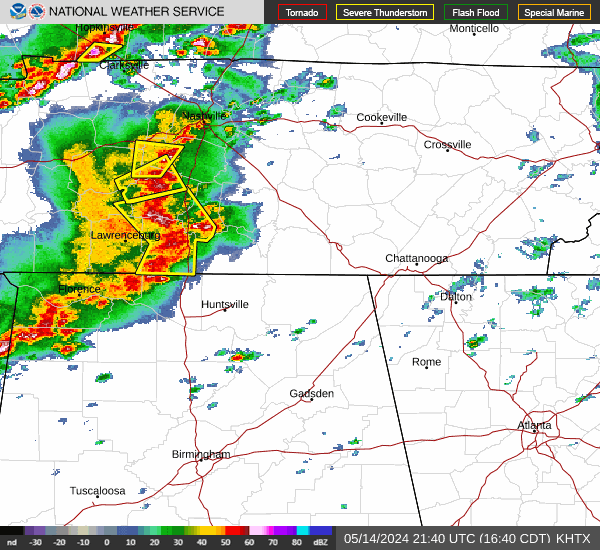
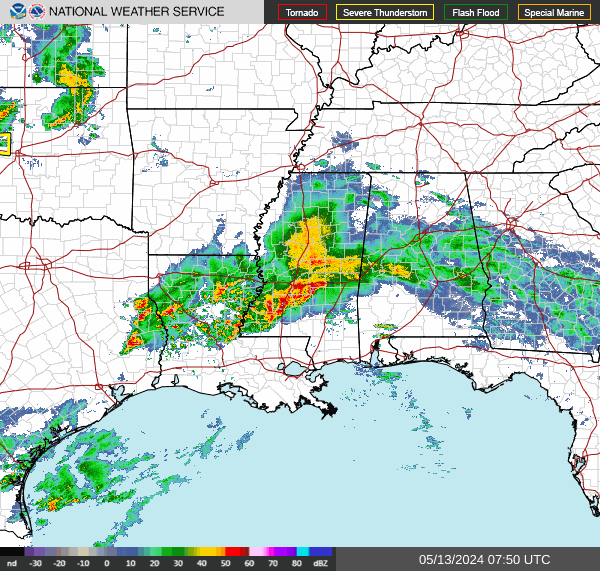




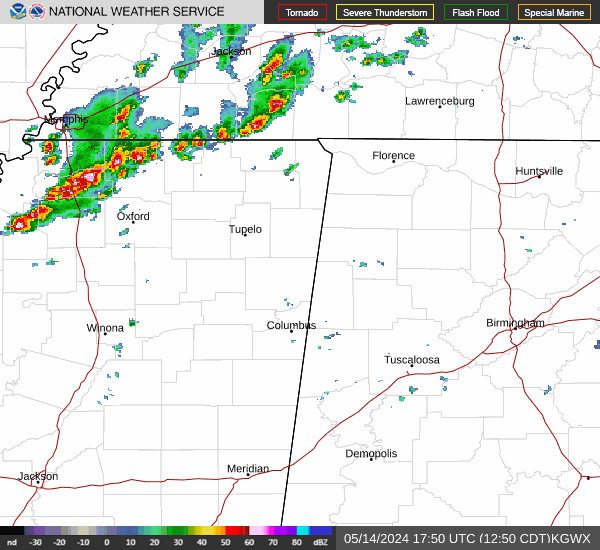
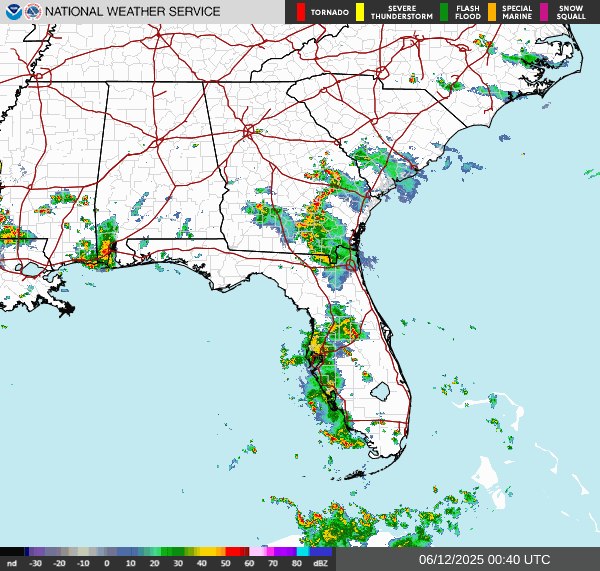
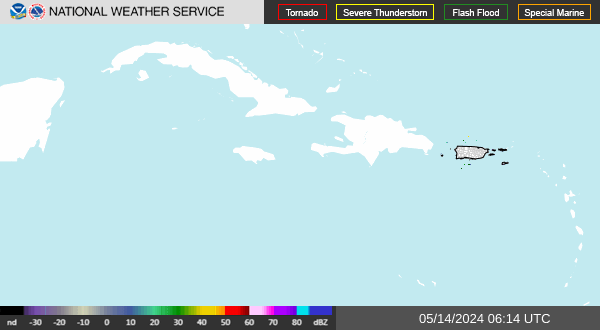




No comments:
Post a Comment